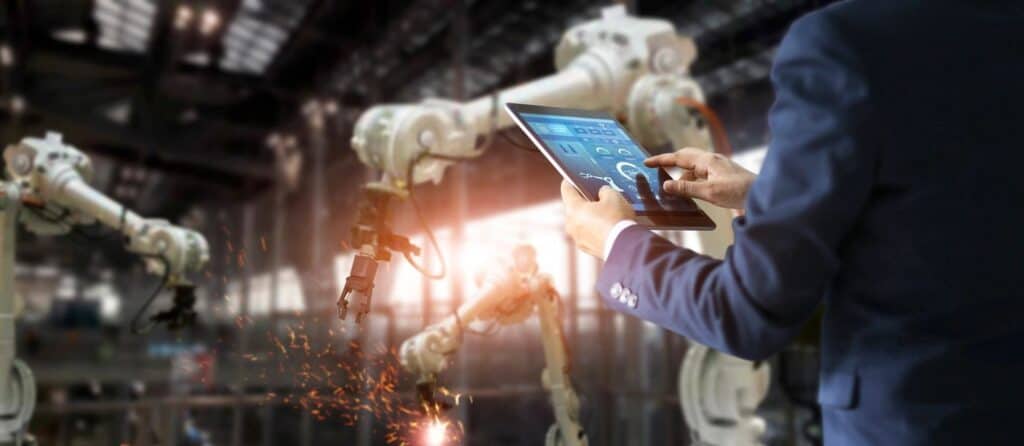In the ever-evolving landscape of logistics, the heartbeat of operational excellence resonates through the corridors of advanced warehouse automation. At WarehouseBlueprint, we stand as pioneers, driving the integration of state-of-the-art technologies to redefine the very fabric of warehousing. Join us on an extensive exploration of the intricate world of automated systems and intelligent machines that are reshaping the fundamental paradigms of warehouse operations.

The Pinnacle of Efficiency: Warehouse Automation Unveiled
1. Automated Storage and Retrieval Systems (AS/RS)
In this era of digital acceleration, where the demand for speed and precision is non-negotiable, Automated Storage and Retrieval Systems (AS/RS) emerge as the vanguards of efficiency. These systems, leveraging robotics and conveyance mechanisms, automate the storage and retrieval of goods with unparalleled accuracy.
Key Features:
- High-Density Storage: AS/RS revolutionizes spatial utilization, enabling warehouses to store an extensive volume of goods vertically, optimizing space.
- Real-Time Inventory Tracking: Every movement within the AS/RS is meticulously recorded, offering real-time visibility into inventory levels and ensuring accurate stock management.
- Rapid Order Fulfillment: AS/RS guarantees swift and precise order fulfillment, minimizing lead times and elevating overall customer satisfaction.
2. Robotics in Material Handling
Embracing the age of automation requires the seamless integration of robotics into material handling processes. These intelligent robots collaborate with human operators, streamlining tasks and ensuring a seamless flow of goods within the warehouse.
Key Advantages:
- Increased Throughput: Robots adeptly handle repetitive and labor-intensive tasks, significantly amplifying overall throughput and efficiency.
- Error Reduction: Automation minimizes errors in picking, packing, and sorting, contributing to higher accuracy in order fulfillment.
- Adaptability: Intelligent robots exhibit adaptability to changes in the warehouse environment, optimizing their routes for maximum efficiency.
3. Conveyor Systems: The Arteries of Automation
Conveyor systems form the arterial network of a fully automated warehouse, facilitating the smooth and continuous flow of goods. These systems manifest in various configurations, including roller conveyors, belt conveyors, and automated sortation systems.
Crucial Benefits:
- Efficient Material Flow: Conveyors eradicate bottlenecks, ensuring a constant and efficient movement of goods from one point to another.
- Reduced Manual Handling: Automation diminishes the need for manual labor in transporting goods, mitigating the risk of injuries and enhancing overall safety.
- Sortation Accuracy: Automated sortation systems meticulously segregate items based on predefined criteria, contributing to enhanced order accuracy.
4. Autonomous Mobile Robots (AMRs)
Autonomous Mobile Robots (AMRs) are ushering in a new era of flexibility and efficiency in warehousing. These self-navigating robots intelligently maneuver through the warehouse, handling tasks such as picking, packing, and transporting goods.
Strategic Integration:
- Dynamic Task Allocation: AMRs seamlessly adapt to changing priorities, ensuring dynamic task allocation based on real-time demands.
- Collaboration with Human Operators: These robots work collaboratively with human operators, creating a harmonious synergy between automation and human expertise.
5. Multi-shuttle Systems: Precision in High-Speed Operations
Multi-shuttle systems bring forth a paradigm shift in high-speed operations within a warehouse. These automated systems efficiently handle the storage and retrieval of goods in a rapid and organized manner.
Operational Advantages:
- High-Speed Order Picking: Multi-shuttle systems excel in high-speed order picking, reducing order fulfillment times and enhancing overall operational efficiency.
- Scalability: These systems are scalable, making them suitable for warehouses experiencing growth and increased operational demands.
6. Pallet Shuttle Systems: Streamlining Bulk Storage
Pallet Shuttle Systems redefine bulk storage by automating the movement of pallets within racks. These systems optimize storage capacity and enhance the efficiency of handling large quantities of goods.
Key Features:
- Deep Lane Storage: Pallet shuttle systems facilitate deep lane storage, maximizing the utilization of available warehouse space.
- Reduced Forklift Dependency: Automation reduces dependency on forklifts, minimizing operational costs and enhancing safety.
7. AutoStore: Revolutionizing Compact Storage
AutoStore introduces a revolutionary approach to compact storage and retrieval. This system employs a grid of bins served by robots, offering a compact and efficient solution for small-item storage.
Strategic Benefits:
- Space Optimization: AutoStore maximizes space utilization, making it ideal for warehouses with limited floor space.
- Scalability and Flexibility: The modular nature of AutoStore allows for scalability and easy adaptation to changing warehouse needs.
Expanding the Horizons: Emerging Technologies in Warehouse Automation
1. Pick-to-Light Systems: Precision in Order Picking
Pick-to-Light systems illuminate the path to precision in order picking. These systems guide warehouse operators to the exact location of items, ensuring accurate and swift fulfillment of customer orders.
Operational Precision:
- Reduced Picking Errors: Pick-to-Light systems significantly reduce picking errors, contributing to higher accuracy in order fulfillment.
- Enhanced Productivity: Operators experience increased productivity as these systems streamline the picking process.
2. Collaborative Mobile Robots: Synergy in Operations
Collaborative Mobile Robots (CMRs) exemplify synergy between human and machine. These robots collaborate with human operators, augmenting efficiency in material handling and order fulfillment.
Collaboration Advantages:
- Flexibility in Operations: CMRs seamlessly adapt to the evolving needs of the warehouse, offering flexibility in various tasks.
- Human-Robot Collaboration: Collaboration between human operators and CMRs enhances overall productivity and operational harmony.
3. Drones in Warehousing: Soaring Efficiency
Drones are soaring to new heights in warehousing, providing aerial perspectives for inventory management, security, and even last-mile delivery. These unmanned aerial vehicles bring a new dimension to warehouse operations.
Strategic Applications:
- Inventory Surveillance: Drones facilitate efficient inventory surveillance, ensuring real-time visibility and minimizing discrepancies.
- Security Enhancement: Aerial monitoring enhances warehouse security, mitigating risks and preventing unauthorized access.
4. Automated Guided Vehicles (AGVs): Navigating Autonomously
Automated Guided Vehicles (AGVs) navigate autonomously within the warehouse, transporting goods with precision. These vehicles eliminate the need for manual guidance, contributing to streamlined operations.
Operational Efficiency:
- Dynamic Path Planning: AGVs dynamically plan their paths, optimizing routes for maximum efficiency and reducing transit times.
- Safety Features: Advanced safety features, including obstacle detection, make AGVs reliable and safe for deployment in busy warehouse environments.
Advantages of Warehouse Automation Over Conventional Methods
The paradigm shift from conventional warehouse methods to advanced automation brings forth a myriad of advantages that define the future of logistics.
1. Precision and Accuracy
Warehouse automation ensures unparalleled precision and accuracy in every aspect of operations. From order picking to inventory management, automated systems minimize errors, contributing to a flawless and reliable process.
2. Enhanced Speed and Throughput
The mechanized nature of automated systems significantly enhances the speed and throughput of warehouse operations. Swift order fulfillment, rapid movement of goods, and efficient utilization of resources characterize the automated warehouse of the future.
3. Worker Safety and Ergonomics
Automation prioritizes worker safety and ergonomics. Collaborative robots, advanced safety features, and the reduction of manual handling contribute to a safer and more comfortable working environment for warehouse personnel.
4. Optimal Space Utilization
Advanced automation technologies, such as AS/RS, AutoStore, and pallet shuttle systems, optimize space utilization. Warehouses can maximize storage capacity and operate efficiently within limited floor space.
5. Real-Time Visibility and Monitoring
Automation provides real-time visibility into warehouse operations. Managers can monitor every aspect of the process, identify bottlenecks, and make data-driven decisions for continuous improvement.
6. Adaptability to Changing Demands
Automated systems exhibit a high degree of adaptability to changing demands. Whether it’s scaling operations, handling new product lines, or accommodating fluctuations in order volume, automation ensures flexibility and resilience.
Overcoming Challenges on the Road to Automation Excellence
While the benefits of warehouse automation are substantial, the journey is not without its challenges. WarehouseBlueprint recognizes the importance of addressing and overcoming these challenges to ensure a smooth transition towards an automated future.
Key Challenges and Solutions:
- Initial Capital Investment: Investing in automation requires a significant upfront capital. However, the long-term return on investment (ROI) and operational efficiency outweigh the initial costs.
- Workforce Transition: Transitioning to an automated warehouse necessitates upskilling the workforce. Implementing comprehensive training programs ensures a skilled and adaptable workforce.
- Integration Complexity: Integrating diverse automation technologies can be complex. WarehouseBlueprint offers expert consultation to simplify integration and ensure seamless functionality.
The Future of Warehousing: Navigating Towards Intelligent Automation
As we stand on the cusp of a new industrial revolution, the future of warehousing is synonymous with intelligent automation. WarehouseBlueprint envisions a landscape where every warehouse is a beacon of efficiency, powered by cutting-edge technologies and guided by a commitment to excellence.
